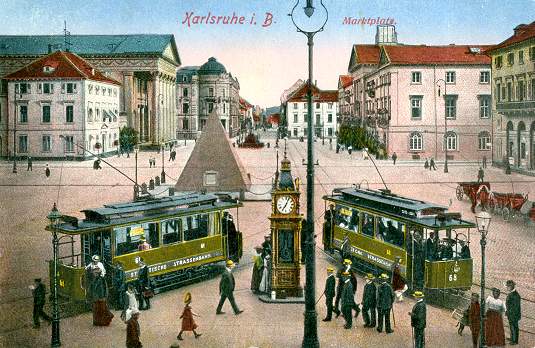

Compared to other German cities, Karlsruhe has a relatively short history. It was founded in 1715 by the Margrave (Marquis) Karl Wilhelm who built his fan-shaped palace here for some peace and quiet. The city of Karlsruhe (the name can be translated as "Karl's repose") lies close to the River Rhine in the west of the state of Baden-Württemberg and developed rapidly to the south and west of the palace. By 1877, the first horse trams (on standard gauge) were on the streets.
A few extensions followed, as did the arrival of a steam tram service in 1881. After several changes in ownership due to poor financial management (in spite of impressive increases in ridership) the Vereinigte Karlsruher, Mühlburger und Durlacher Pferde- und Dampfbahngesellschaft improved the situation. In 1894, the AEG concern took the company over and formed the Karlsruher Strassenbahn-Gesellschaft with the idea to electrify the system. Electric trams first ran in February 1900 when the steam trams were replaced, with the horse trams being replaced a few weeks later. Although much of the electric tramway used conventional overhead, a sizeable number of cars (27 out of the first 46 two-axle cars) also had batteries or accumulators fitted for routes that passed through the city centre because 'unsightly' overhead wires were not welcome there. However, just three years later, city centre wires were erected and the use of batteries ended. This allowed easier extension of the tramway network as the city expanded and the system came under municipal ownership during 1903.
Our postcard shows cars 61 and 68 at Marktplatz, looking south with the prominent and pyramidal monument to Karl Wilhelm in the mid-distance. The card was published by 'G.M.K' of Karlsruhe as series no. 4490 and dates from between about 1905 and 1907. (Apart from more modern trams, this particular cityscape is much the same today). The cars themselves are thought to be from a batch of ten built by Maschinenfabrik Nürnberg in 1905, which had two-axle trucks fitted with 2x39kW motors. Inside, the cars had room for 20 seated and 24 standing passengers.
Of further, but related, interest is the Karlsruhe Albtalbahn. This was originally a metre-gauge railway with 'tramway character' opened in 1897 and running from Karlsruhe to Bad Herrenalb and Ittersbach, both about 25km south of the city. Electric cars were also used from 1898 but then exclusively after 1911 when steam traction ended. In stages from 1958 to 1964, the Albtalbahn was re-gauged to standard gauge when it could be fully interworked and integrated with the city tramway system.
Today, the city tram network is operated by the Verkehrsbetriebe Karlsruhe GmbH (VBK) and the surrounding area by the Albtal-Verkehrs-GmbH as urban or interurban tramways on the so-called 'Stadtbahn' principle. Extensions to the 'Stadtbahn' system have taken over Deutsche Bahn (DB) lines in the area and, with suitable connections and new street-running sections, enable modern tramway vehicles to travel from Karlsruhe city centre to, for example, Baden-Baden (30km to the west), Heilbronn (80km to the east), Pforzheim (30km to the south-east) and Freudenstadt (75km to the south).
The city tram routes use trams running on 750v DC. Trams operating both the Albtalbahn and 'Stadtbahn' sections use 750v DC but have railway-profile wheels.Trams capable of using tramway, 'Stadtbahn' and DB sections also have railway-profile wheels but can operate with 750v DC or 15kV AC. Currently, approximately 140 modern articulated trams operate the various services in this fascinating and attractive area of southern Germany.
The so-called 'Karlsruhe model' for integrated interurban tramways has been highly successful in recent years and is being implemented, trialed or seriously considered in many areas of the world, including the UK. From such small and early beginnings, it is hard to believe the impressive changes we see today.
![]() Go to Postcard Of The Month Index
Go to Postcard Of The Month Index